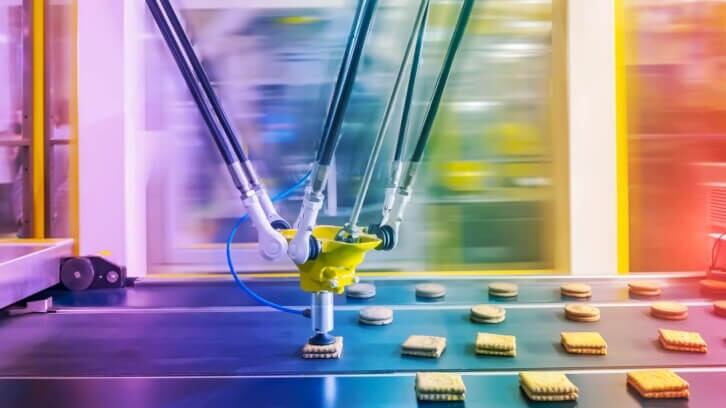The manufacturing landscape is rapidly transitioning to a smarter future with the adoption of new technology, driven in no small part by the continued challenge presented by continued labour shortages. The issue is hardly news to the sector but with nearly 70,000 vacancies in UK manufacturing, it is a major challenge and one that businesses have had to address while simultaneously dealing with supply chain issues, the rising cost of resources and material shortages.
Meanwhile, the problems that arise as a result of ageing manufacturing solutions are set against increasingly stringent regulatory requirements and rising consumer expectations in every market.
An intensified focus on smart maintenance was perhaps inevitable but it is an area in which we are now witnessing a step-change facilitated by innovative technologies. Leveraging the advantages offered by collaborative robots and AI it is a transition which will see significantly increased collaboration and data sharing between IT and shop-floor operations.
As the possibilities for practical application have expanded, it is easy to see why the adoption of these particular forms of automation has gathered pace. Technologies such as collaborative robots can now move loads of 25kg or more, while enabling the unique value that humans can deliver to a process.
Similarly, technologies such as AMRs which can carry loads of many sizes ranging from batches of small product to large pallets weighing up to 1.5 tonnes are proving to be an effective way of moving goods throughout the factory. This has significantly increased the level of agility and flexibility within the manufacturing process and has largely negated the need for safeguarding operating envelopes due to the inherently safe nature of the technology.
At the same time AI is already making huge inroads in manufacturing, with many instances where data modelling has led to notable efficiency improvements across a multitude of factory scenarios.
The adoption of new traceability solutions is simultaneously enabling food manufacturers to respond to the rising demand for ethically production methods. Initiating traceability projects has proven to be a relatively low cost and low risk gateway to factory digitisation, providing greater transparency of their supply chains from farm to fork.
But maintenance remains a substantial challenge for the manufacturing sector, with companies spending on average 20 hours per week on unscheduled maintenance and over £5,000 on every hour of plant downtime. Ultimately, by drawing upon machine learning and artificial intelligence, companies can improve productivity and protect their bottom line.
The rise of predictive maintenance
Over the last two decades, technological advancements have paved the way for predictive maintenance to complement reactive and regularly scheduled maintenance in manufacturing plants. Predictive maintenance utilises asset-connected sensor data, advanced analytics, and associated technologies to anticipate asset maintenance requirements. By integrating devices with the Internet of Things (IoT) and monitoring sensor data related to factors such as equipment temperature, vibration, flow and pressure, engineering managers can identify patterns and intervene before failures occur, optimising equipment lifetime and minimising downtime.
The benefits of predictive maintenance are numerous, including improved uptime, greater predictability and lower service costs. The chief benefit lies in enhanced maintenance maturity, which improves productivity and reduces the risk of failure. Companies worldwide are recognising these benefits and investing in predictive maintenance technologies to great success. In a study by consultants at McKinsey, one company’s condition-based maintenance system – which used data from the industrial IoT connected devices and a historical service database – cut downtime and parts costs by almost a third.
The future of smart maintenance: using data and technology to predict faults
While predictive maintenance marks a significant improvement over traditional approaches, the ultimate evolution of smart maintenance lies in leveraging data and AI not only to predict faults but to prevent them.
Prescriptive maintenance goes beyond predictive maintenance by using machine learning and artificial intelligence to adjust operating conditions for desired outcomes and intelligently schedule asset maintenance. Algorithms can analyse historical data to simulate various operating conditions and extrapolate data to provide hypothetical operating environments, allowing managers to test the effects of small adjustments on an industrial process, meaning expensive and risky experimentation can be performed in a computer simulation. The insights derived from prescriptive maintenance technologies can help delay or entirely eliminate equipment failures.
Making the digital transformation a reality
According to a survey by RS, while digital technology is already ubiquitous across maintenance engineering, many take it for granted, with only 16% of engineers saying they use the industrial IoT and fewer than one in five planning a digital transformation.
Despite the promise of prescriptive technology, many maintenance managers are also still using Excel spreadsheets and relying on paper records. There is a poor integration between different technology platforms, and the true benefits of data-driven maintenance are not being realised due to a lack of synergy between IT and shop-floor operations.
Factory of the future
Smarter maintenance must involve simplifying communication technologies and enhancing data sharing to create greater synergy between IT and shop-floor operations. To do this, it is key to build critical relationships but also to simplify the technology – for example, by removing unnecessary components (lineside PC) to enable communication straight from the machine to a cloud database. In addition, the use of ‘edge’ computing will enable managers to transfer only the data that needs to go to the cloud, increasing data efficiency.
Achieving greater synergy between IT and shop-floor operations will be no easy feat, and yet the potential benefits are vast, including a potential Machinery-as-a-Service business model, reduced on-site services, lower-risk warranty extensions, and increased production analytics for continuous process improvement.
Meanwhile, the next challenge for AI is to improve product quality. Real world progress is already being made in the ways that defects which are very difficult for traditional inspection systems to find, are identified. For example, finding small scratches on a matte black material is a notoriously difficult challenge for those involved in product inspection.
By using AI, this becomes relatively simple by using pre-trained models alongside traditional inspection methodologies. With as few as 50 good images, it will be possible to train the AI algorithms to identify good and bad images at high speed. Similarly, natural deviations, due to light for example, can be mistaken for defects in traditional inspection deployments. Using AI to anticipate these variations will eliminate rejection of ‘good’ products unnecessarily.
Ultimately, the combination of new technologies and automation will not only address key challenges such as labour shortages and see greater harmony between human and machine, but help the food manufacturing industry respond to consumer demand, meet wide ranging stakeholder obligations, and operate more effectively, profitably and sustainably.
In other news, a number of notable food and drink products manufactured in the UK have been granted special protected status in Japan.




